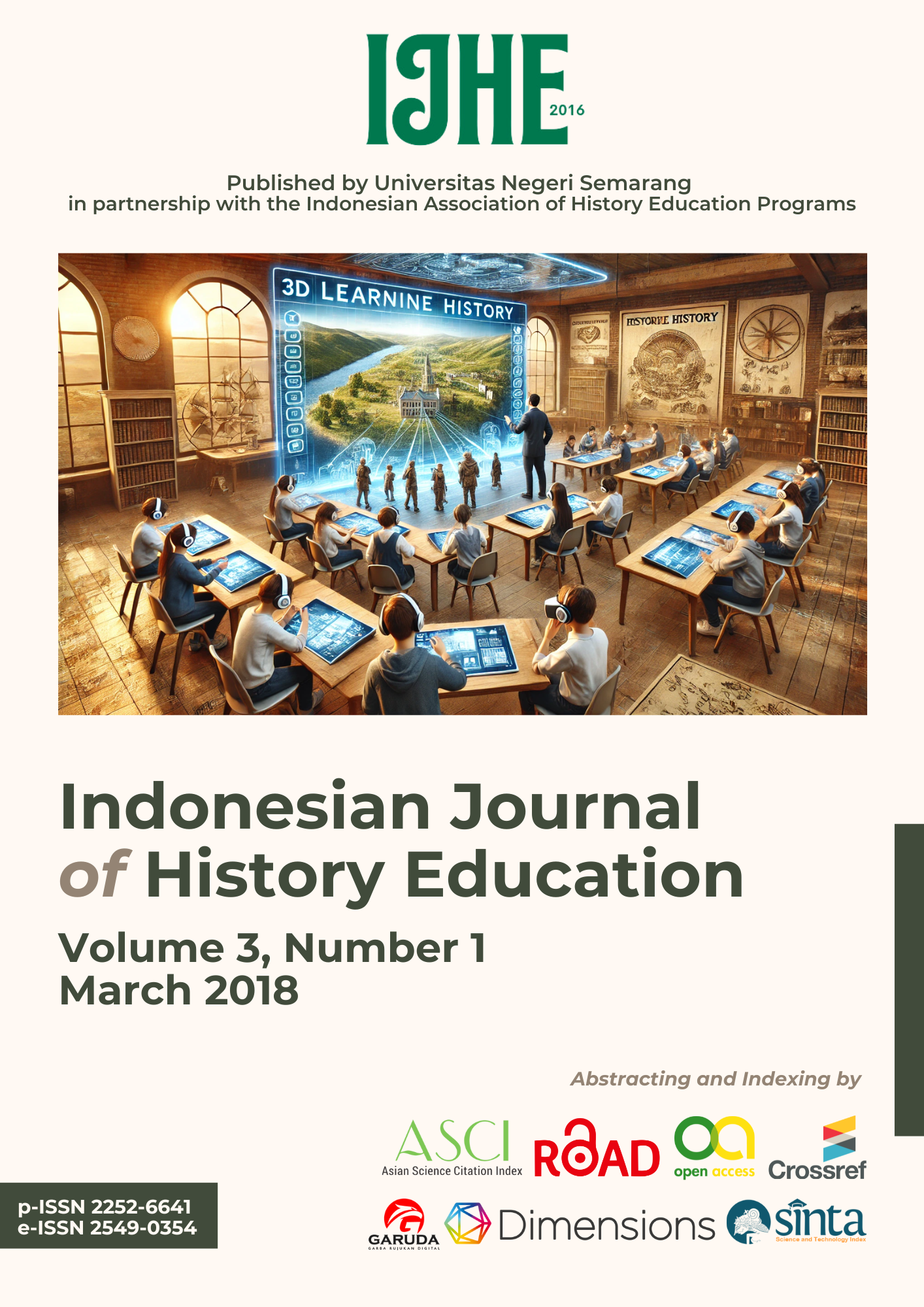The Effectiveness of History Learning Using a Learning Model E-Learning
Abstract
The results of preliminary observations about the learning process at SMA 9 Semarang reveal that the school must utilize model-based learning or e-learning facilities to procure models. Despite having adequate e-learning resources such as hotspot areas, LAN, projectors, and computers, these tools must be employed more effectively in the learning process. The many advantages of the e-learning model, including enhanced engagement and accessibility of materials, have led the authors to be interested in experimenting with implementing e-learning in teaching methods at the school. This study aims to address several fundamental problems: (1) how the application of learning models on the lecture material of Colonialism and Imperialism in Indonesian West is implemented in Class XI Social at High School 9 Semarang, (2) how the implementation of e-learning materials on Colonialism and Imperialism in Indonesian West is carried out in Class XI social education at High School 9 Semarang, and (3) how effective is the use of e-learning materials on Colonialism and Western Imperialism in Indonesia in enhancing the learning of history in Class XI Social at High School 9 Semarang. These questions will guide the research to explore the potential benefits and challenges of integrating e-learning into the traditional teaching methods at the school. Through this study, the authors hope to provide insights into the effectiveness of e-learning in improving the educational experience and outcomes for students and identify best practices for its implementation in similar educational settings.
References
Anni, C. (2006). Psikologi belajar. UPT Unnes Press.
Anonim. (2010). Pendidikan karakter: Strategi membangun moralitas anak secara efektif. Diunduh dari http://id.wikipedia.org/wiki/Pembelajaran_elektronik/ pada 22 Desember 2012 pukul 11.00 WIB.
Anonim. (2012). Pengertian e-learning. Diunduh dari http://www.masie.com/ pada 12 Desember 2012 pukul 08.00 WIB.
Anwas, O. M. (2003). Model inovasi e-learning dalam meningkatkan mutu pendidikan. Jurnal Teknodik Depdiknas Edisi No. 12/VII/Oktober/2003.
Arikunto, S. (2002). Dasar-dasar evaluasi pendidikan. PT Rineka Cipta.
Arsyad, A. (2011). Media pembelajaran. Academia Edu.
Auliyanti, S., Achmad, A., & Marpaung, R. R. T. (2015). Pengaruh Penggunaan E-Learning Terhadap Aktivitas dan Hasil Belajar Siswa Pada Materi Virus. Jurnal Bioterdidik: Wahana Ekspresi Ilmiah, 3(4).
Darsono, M., dkk. (2000). Belajar dan pembelajaran. IKIP Semarang Press.
Gottschalk, L. (1985). Mengerti sejarah. UI Press.
Hartutik. (2006). Efektivitas pembelajaran biologi SMA dengan pendekatan jelajah alam sekitar (JAS) berdasar analisis SWOT dalam kemasan CD interaktif. [Online]. Tersedia.
Irene, A. S. (2003). Pengembangan kecakapan hidup (life skill) melalui penanaman etos kerja dan membangun kreativitas anak. Cakrawala Pendidikan Jurnal Ilmiah Pendidikan; Lembaga Pengabdian Kepada Masyarakat; Universitas Negeri Yogyakarta.
Kamarga, H. (2002). Belajar sejarah melalui e-learning. PT Intimedia.
Kartodirdjo, S. (1992). Pendekatan ilmu sosial dalam metodologi sejarah. PT Gramedia.
Kuntowijoyo. (1995). Pengantar ilmu sejarah. Yayasan Bentang Jaya.
Margono. (2009). Metodologi penelitian pendidikan. Rineka Cipta.
Muslikhin. (2013). Modul Pelatihan E-learning. Academia Edu.
Na’imah, N. J., Supartono, S., & Wardani, S. (2015). Penerapan pembelajaran berbasis proyek berbantuan e-learning untuk meningkatkan hasil belajar siswa. Jurnal inovasi pendidikan kimia, 9(2).
Permata, D. B., dkk. (2009). Portal aplikasi flash sebagai media e-learning interaktif. Seminar Nasional Aplikasi Teknologi Informasi 2009.
Santyasa, I. W. (2005). Model pembelajaran inovatif dalam implementasi kurikulum berbasis kompetensi. Makalah disajikan pada Penataran Guru-Guru SMP, SMA, dan SMK se Kabupaten Jembrana Juni – Juli 2005 di Jembrana.
Soekartawi. (2003). Prinsip dasar e-learning: Teori dan aplikasinya di Indonesia. Jurnal Teknodik Depdiknas Edisi No. 12/VII/Oktober/2003.
Suartama, I. K. (2015). Strategi pengembangan dan pemanfaatan e-learning dalam proses pembelajaran. In Proceeding Scientific Forum-Faculty of Education Departement of Science Education (FIP-JIP) and The International Seminar (Vol. 1).
Supriani, Y. (2016). Menumbuhkan kemandirian belajar matematika siswa berbantuan quipper school. JIPMat, 1(2).
Supriatna, E. (2011). Pendekatan Konstruktivisme Dalam Pembelajaran Sejarah Untuk Menumbuhkan Berfikir Kritis Siswa Melalui Pembelajaran Berbasis Masalah. In Makalah disampaikan pada acara seminar Internasional ASPENSI.
Sutomo, M. (2012). E-learning sebagai Alternatif Model Pembelajaran dalam Upaya Meningkatkan Mutu di perguruan Tinggi. Jurnal Falasifa, 3(1), 149-159.
Yudiono, K. S. (2010). Pengantar sejarah sastra Indonesia. Grasindo.
Copyright (c) 2018 Heros Satrio Wibowo

This work is licensed under a Creative Commons Attribution 4.0 International License.
Copyright Notice
An author who publishes in the Jurnal Indonesian Journal of History Education agrees to the following terms:
- Author retains the copyright and grants the journal the right of first publication of the work simultaneously licensed under the Creative Commons Attribution-ShareAlike 4.0 License that allows others to share the work with an acknowledgement of the work's authorship and initial publication in this journal
- Author is able to enter into separate, additional contractual arrangements for the non-exclusive distribution of the journal's published version of the work (e.g., post it to an institutional repository or publish it in a book) with the acknowledgement of its initial publication in this journal.
- Author is permitted and encouraged to post his/her work online (e.g., in institutional repositories or on their website) prior to and during the submission process, as it can lead to productive exchanges, as well as earlier and greater citation of the published work (See The Effect of Open Access).
Read more about the Creative Commons Attribution-ShareAlike 4.0 Licence here: https://creativecommons.org/licenses/by-sa/4.0/.




